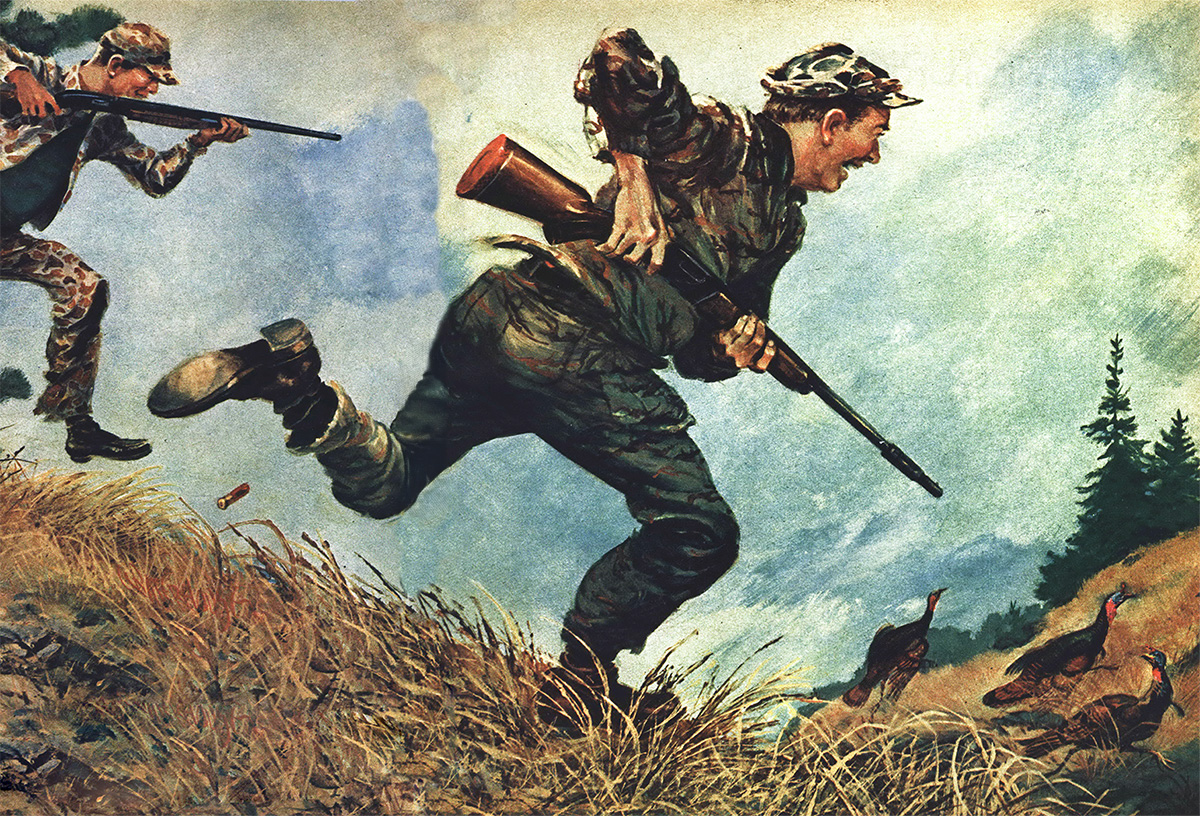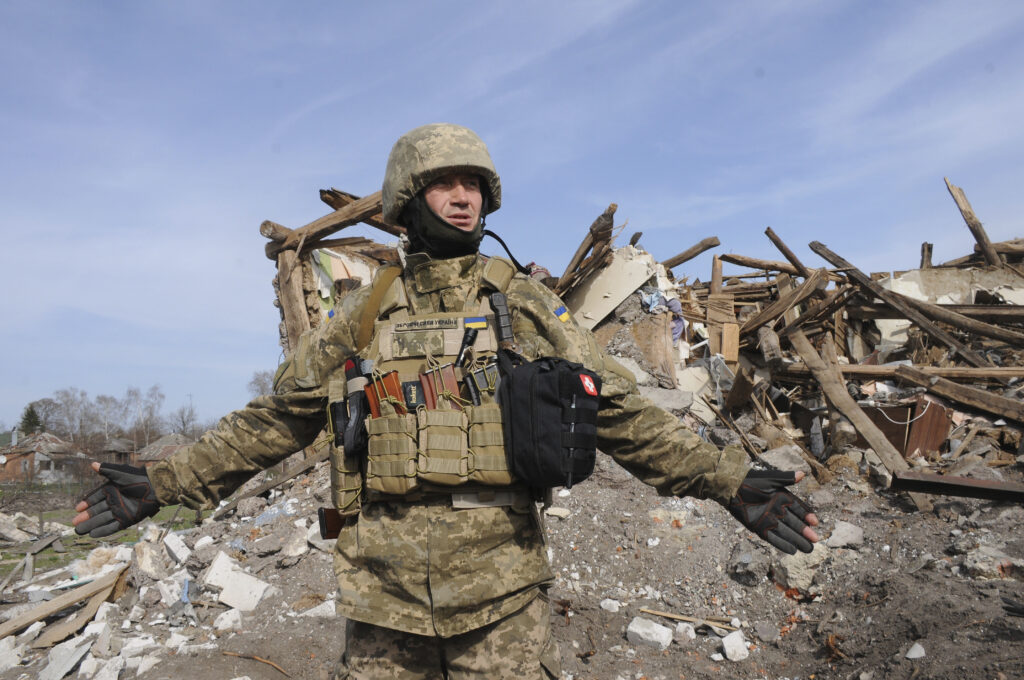My Buddy Took Me Turkey Hunting, Then Shot My Bird Out from Under Me

This story, “Tax-Time Turkey,” appeared in the March 1973 issue of Outdoor Life.
Getting kicked by a horse is sure a damned painful way to put a turkey hunt into gear, but it’s worth it, I thought as I hefted the bedraggled 18½-pound gobbler with both hands to keep from losing my grip on a pair of legs that were slippery with swamp mud and slime.
The hunt had just come to an end, right after first light on a morning when I should have been struggling with my income-tax forms — April 15, 1972.
Instead, the yelps and clucks from three calls orchestrated by Dr. H. S. (Buck) Banton had resulted in our facing down a pair of Alabama gobblers in an area that didn’t have a single turkey before 1956.
That morning, after my partner had received permission to hunt, the Union Springs, Alabama, medico parked his four-wheel-drive near some cattle pens on grazing lands that are owned by Jeff Sorrel. We quietly closed the doors of the 4WD and then loaded our shotguns. We hadn’t hiked half a mile down a cattle path when we heard the first turkey gobble. Then an ow I hooted.
“Listen, now,” Banton cautioned in a whisper. “Owls always get ’em to gobbling.” I stopped in my tracks and listened. Sure enough! In a swamp and just off to our left, a roosting tom turkey spouted off. Within seconds, the first bird we had heard answered. Two birds were within easy continued calling distance of us!
“That one’s not too far off,” the doctor whispered, nodding toward the swamp. “Wish I knew if he was on the other side of that creek. Let’s pussyfoot into the swamp a little way and see.”
Our progress over the mucky bottom was hardly Indian-like, but we did our best, mindful of the turkey’s reputation for wariness. We halted when we were about 75 yards into the swamp, and Banton brought out his “gobbler box.” He rattled the rig vigorously. An angry answer to this challenge came immediately, dead ahead, another 75 yards off, Banton later estimated. But you couldn’t prove it by me — I had no idea how far a turkey’s gobble would carry, or how to estimate a calling bird’s location.
A few years back, my home state of Wisconsin stocked some turkeys. But four or five years ago, after a couple of very restricted seasons, hunting was closed again. I’d passed up the limited opportunities in the Badger State since I don’t care for lotteries and regimented hunting; besides, outside of making a professionally guided turkey hunt in Florida, I was a rank beginner at the sport.
On this, my third morning in south-Alabama turkey country, I had begun to grasp some of the basics. The fascination of hunting this big-game bird was beginning to get to me, although not as much as Buck Banton had threatened it would when we renewed our acquaintance the day before.
“I warn you, Duff,” he said. “Don’t get going on this turkey hunting. When I got hooked, I sold all my bird dogs and neglected my practice. Just this year when my daughter told me she was going to get married, I asked when. ‘Oh! Don’t worry, Daddy,’ she said. ‘It’ll be long before turkey season.’”
When the swamp gobbler sounded off, we froze. Then, following Banton’s hushed instructions, I found a big sweetgum tree to hunker down against to keep my butt out of the wet mud. The mosquitoes crawled in through the eyeholes of my mesh face mask, and I knew I’d have a long, uncomfortable wait. I envied Banton the folding stool he toted.
Offering me a quickly broken-off leafy branch, Banton whispered: “Stick it in the mud in front of you. It’ll break your outline. And if a bird comes in from behind, don’t peek around that sweetgum tree you’re backed up against.”
In a swamp and just off to our left, a roosting tom turkey spouted off. Within seconds, the first bird we had heard answered.
The leafed-out trees and 80-to-90-degree temperatures were a far cry from the snow and cold that plagued Wisconsin, which was still trying to break out of its second-worst winter since World War I.
I needed every ounce of my will power to keep from shifting my aching legs or brushing mosquitoes. My Alabama mentors had stressed the importance of immobility and silence when a tom turkey is nearby.
The morning before, on Friday, Banton and I were out hunting with Charles Reams, an Alabama conservation officer who is stationed at Union Springs. We’d heard five different gobblers. But we spooked only one tom that had gotten down on the ground early, and we saw three hens taking dust baths on a sunny hillside 150 yards from where we were hidden. None of the other gobblers that we’d heard responded to the yelps and clucks Reames scraped from a cedar-box call.
“You know, if those big old birds could smell you, there just wouldn’t be any of them shot,” Reames said, when we finally gave up and walked out.
For as any turkey hunter will tell you, the big, ugly birds make up for any lack in sense of smell with their microscopic vision and stethoscopic hearing. A hunter’s motion or noise can eliminate any chance of bagging this elusive trophy.
But Buck Banton contends that “turkeys are really stupid, though they have great senses.” Banton’s seemingly paradoxical viewpoint might anger those backwoods philosophers who have painted the wild turkey as some sort of Avis genius, and the doctor’s comment is particularly surprising coming from a man who freely admits he went out for turkey 34 times before he bagged his first one. The big bronze birds apparently do have mental lapses, however, and gobblers may be bagged under unusual circumstances.
By Saturday, I was in no position to argue against Banton’s logic, and the circumstances that had led to my being hunkered down against a sweetgum, straining my muscles and holding my breath, were already on the bizarre side.
I had been covering the 1972 National Shooting Dog Championship for OUTDOOR LIFE (see “Shooting Dog Championship,” June 1972) late in February, when a horse, apparently aiming at my mount with a well-shod hoof, missed my horse and nailed me instead. Fortunately, the kick didn’t break my right shinbone, but it did cause a nasty gash that needed something more than gritted teeth and a stick-on bandage.
Some friends prescribed a healthy snort of bourbon and a trip to the doctor. Reames, one of several conservation officers assigned by the state to help out at the dog trial, drove me to the hospital, where it was Dr. Banton who stitched me up during the lunch-hour so I could ride the remainder of the trial without missing anything.
The upshot of that painful first meeting with the game warden and the small-town doctor was an invitation to come back down a few weeks later to sample Alabama’s spring turkey season. In Bullock County, the season would run from March 20 through April 30, with a bag limit of one per day, five per season. The cost of a nonresident trip license, good for seven days, was only $10.15.
Because of the severe winter back in Wisconsin, we had decided to extend into May the shooting season at the licensed hunting club that I manage, so I had doubts about being able to get away for even a couple of days. From what I’d been told about turkey hunting, it seemed foolish to expect to bag a bird in so short a time.
But after I returned home, the snow and cold of Wisconsin’s winter stretched on and on, and the prospect of a turkey hunt in sunny Alabama became more and more attractive. Sick as I was of bad weather, it was the income-tax forms that finally made up my mind. I turned the forms over to a tax specialist, begged some time off, and then phoned Reames.
“I’ve had it. I’m ready. What’s with those turkeys?” I asked.
“Be at my house at four Thursday morning,” the conservation officer answered. “We ought to get you a turkey. They’ re really gobbling now, and I’ve called up nine birds for guys to shoot so far this year.”
That was the clincher, even though a 1,200-mile bird-hunting trip takes some finagling when you’re busy and it’s income-tax time. But thanks to understanding bosses and credit cards, I flew out of Green Bay, Wisconsin at 6:10 p.m. Wednesday, April 12.
Before I’d had time to congratulate myself about losing only some sleep and saving $20 round trip by flying night-coach rate, it became obvious that operating on a tight budget and schedule might well cost me the first morning of hunting. Bad weather socked in busy O’Hare field in Chicago, and I didn’t arrive in Montgomery, Alabama until 1:00 a.m. on Thursday. No rental cars were available, and the $20 I’d saved by flying at night went for the cab that deposited the gear and me on Charles Reames’s doorstep about 50 miles south of Montgomery, at 3 a.m. Reames dressed, and I changed into camouflage clothing. We were in the woods by 4:30 a.m.
It had been some time now since Banton had moved into position at my right rear and had scraped the last sound from his slate call. Then the unmistakable gobble of a tom rattled in from our right.
But it was a bad morning in Dry Creek bottom. Wind is bad for any kind of upland hunting — disastrous when you’re after turkey. The birds become extra-wary, and they can’t hear the plaintive yelps, wails, and clucks that a good caller uses to convince an amorous tom that a glamorous female is lurking in the bushes and desires the pleasure of his company.
A tom turkey that’s come a’courtin’ is something else. Once he pinpoints the hen’s location, he puts on a real show. Wing tips actually get worn down, and breast feathers are rubbed off as the tom struts, sweeps the ground with outspread wings, and then leans in toward the hen’s woodland boudoir, his wattles angry red as he demands the hen’s favors.
It is this mating drive that dulls the ultra-cautious instincts of the male bird, turning him into a belligerent show-off as he tries to impress the ladies and to drive off competing young toms.
This spring “gobbling” season is a red-letter time on the calendars of hunters in almost half the states in the U.S. Whether the fascinating courtship procedures are enjoyed by birdwatchers and camera bugs, or hunters cuddling turkey calls, the buildup of turkey numbers in states and areas where the big bird hasn’t existed since Civil War times can be credited to practical game management and the support of landowners and sportsmen who have provided the places and the money to establish, feed, and protect wild-turkey flocks.
An excellent example of such an effort is the area I was hunting. Bullock County, one of Alabama’s less-affluent rural areas, didn’t have turkeys before 1955.
“We used to get kidded all the time about being ‘rabbit wardens,’” reported Captain J. B. Barbaree, who as conservation officer in the area was instrumental in establishing the wild-turkey program. “Just quail and rabbit. No turkey. No deer. Now we’ve got both.”
The first wild turkeys, 16 hens and four toms, were trapped near Jackson, Alabama. In 1957, the birds were stocked in what was called the Double Creek management area near Perote, an area of about 8,500 acres. Another block of 10,000 privately owned acres near Saco was closed and stocked with 21 turkeys in 1958-1959. These lands were inexpensively leased by the state and were set up as experimental refuges. By 1963, there were enough birds from this original stocking to warrant an open season.
Conservation agents now estimate that more than 4,000 turkeys are scattered through Bullock County and adjacent Pike County, and turkey hunting has become a passion with area residents. Accurate kill-counts are not available, but turkey hunting seemed to be a leading conversational gambit while I was hunting there; big 16-to-22-pound birds were frequently bagged.
Conservation officers who are dedicated to protecting the big birds seemed in solid agreement that many more turkeys could safely be taken. Some counties also have a fall turkey season that runs concurrently with the open season on deer. (Alabama boasts a nearly unbelievable deer season, running from November 15 to January 15 with a bag limit of one deer per day.)
Many turkey hunters oppose the fall shooting because the turkeys are flocked up then, and shooting into a flock can hike hen mortality, even though only toms are legal, as in the spring.
“Beards,” which actually hang from chests rather than chins, identify the old toms, although an occasional “bearded lady” may show up and be confused with a young gobbler just beginning to sprout this coarse growth.
But bearded hens are very rare. And when a gobbler is called into shotgun range, the brighter coloration on his head is another identifiable sex characteristic. A tom’s head-furnishings are a striking red, white, and blue; the drabber hen, however, is bluish around the head.
Alabama’s wild turkeys are of the Eastern race, the most common. Other states have the Florida, Rio Grande, Merriam, and Mexican races of the same species. Despite the vulnerability of turkeys at mating time, it is estimated that the nationwide kill by hunters is less than eight percent of the population.
The part of Alabama where I hunted has some important things going for it in favor of turkey propagation. It is cattle country, and enormous tracts of land (by Eastern standards) are privately owned and leased. Cattle ponds and the area’s relative isolation have benefitted the turkey. In addition, landowners like Jeff Sorrel — whose tract was the largest that was part of the original management area — along with sportsmen like Dr. Banton, have continued to plant good turkey forage like chufa (also known as ground almond), a sort of peanut-like annual that is much favored by the big birds.
Permission that is required to hunt private lands isn’t always easy to get — which makes for good turkey shooting by keeping down the number of hunters. Serious turkey hunters want to have big blocks of country to themselves.
In neighboring Barbour County, however, a large management area held the state is open to public hunting, and it holds descendants of the three-dozen wild turkeys that were stocked there between 1953 and 1957, and spill-over birds from private lands in Bullock County.
Because poaching has always been a threat to turkey survival, stepped-up law enforcement also rates some credit in establishing and maintaining Bullock County’s prime turkey flock. But law enforcement officers like Reames and Captain Barbaree say that the public’s attitude now leans toward tight protection, and the prosecution of lawbreaking hunters.
“People around here are proud to have turkeys, something they never enjoyed before, and we get good cooperation,” said Barbaree. “Even though hunting pressure is growing every year and the hunters are learning to hunt better, this area pride and the private ownership of land make any danger of overkill unlikely.”
There’s plenty of time for talk on a turkey-hunting trip, and I asked my partners a lot of questions about the birds as we hunted during those early-morning hours before and just after the gobblers leave their nightly tree roosts.
As proof of Buck Banton’s claim that turkeys sometimes do dumb things, we even bagged one 17-pound tom in the late afternoon on Friday. Banton, Reames, and I were driving through an open pasture, not actually hunting at all but just exploring, when Reames spotted a bird. Banton bailed out of the vehicle, loading on the run; three toms ran down the cut ahead of us. Banton flopped the last bird, and the two others took off. But only one bird kept flying; the other one landed in a big pine. I passed up the “dumb” bird that was sitting in the tree.
“I still want to see you call one of those rascals in,” I said. “That’s what turkey hunting’s supposed to be all about.”
“You just wait until tomorrow morning,” Banton replied. It was “tomorrow morning” — the last day of our hunt — when I was squatting with my back against the big sweetgum, holding as still as my cramped legs would allow and twitching my facial muscles to shake off mosquitoes. I had that “knowing feeling” that often comes to hunters. I was about to tangle with my tax-time turkey. And judging by the gobbles, we had two toms to contend with.
It had been some time now since Banton had moved into position at my right rear and had scraped the last sound from his slate call. Then the unmistakable gobble of a tom rattled in from our right. This gobbler was a newcomer, unless the bird we’d been working on had sneaked out of the roost and was stealing in on the ground. My last shred of composure snapped when I heard a soft cluck and realized it wasn’t Banton’s call, but a real hen, just off to our right rear.
Then it was Banton’s turn. To my ears the cluck of his call was even more seductive than the real thing.
“I had to give it one more,” Banton explained later. “I didn’t want that bird leaving us for the hen.”
The gobbler on the ground really rattled off a string of harsh chatter. That did it! The turkey in the tree was brooking no interference from the old boy that was walking in on our right; he spoke up, too. The next thing I knew, something that looked as big as a B-29 with the bomb bays open came coasting into the swamp-opening at our front.
When you see a turkey at a distance on the ground, he’s a stately bird. He’s beautiful with the sun on his black-and-bronze feathers, his red, white, and blue head glistening. But up close, his warty wattles are ugly, and in flight he looks like a ruptured buzzard.
The tom I was watching plunked down awkwardly onto the muddy ground. Suddenly I was at ease and thinking. “Don’t move,” I’d been told, “until the bird gets behind something where he can’t see you.”
Read Next: The Best Turkey Loads, Tested and Reviewed
The gobbler took a couple of steps before he was screened by a huge tree. I started easing up my full-choke 12-gauge Remington Model 870 pump. It had No. 6 shot in the chamber, No. 4’s for back-up. Many a turkey is taken with No. 2 shot, but I thought I needed more pattern density for the head.
“For Pete’s sake, Dave, shoot!” Banton yelled.
Galvanized into action, I was settling the gun to my shoulder when Banton’s autoloader blasted In seconds the thrashing turkey was spraying Banton with mud and water as he grabbed it. The doctor is a large, bulky man — but that morning, no track star could have made better time to the downed bird.
Sloshing back through the mud with the wet, dead bird, he shook his head.
“What a helluva thing to do,” the doctor said. “Carry a man hunting and then shoot his bird.” But he quickly took the offensive. “What were you waiting for? You didn’t even have your gun up. You should have got it up when he came flying in. They have to concentrate on where they’re landing, clumsy as they are, and he wouldn’t have seen you move. I thought sure you’d blow it and he’d get away.”
“Now you tell me,” I said, laughing. “But there was no way that bird could have gotten away. He wasn’t more than twenty or twenty-five yards from me. Soon’s he came out from behind that tree, he’d have been a goner.”
“Hunh!” Banton snorted. “Couldn’t get away? He most likely would have kept that tree between you and him and you’d have never got a shot. You can’t depend on a turkey to do anything but sneak away from you. You gave him all the chance he needed to get away. Hell, man, when I started turkey hunting I used my twenty-gauge Parker double. ‘Cause I also killed quail with it, I thought it was sporting. Now you see what I’m shooting?”
He waved his 3-inch 12-gauge Magnum Remington Model 1100, tipped with a Cutts Compensator. “And if a 10-gauge wasn’t so damned heavy, I’d carry one of them.”
“But I’d rather not take a little bird like this back up North anyway,” I said. “I wanted something to brag about.”
By this time I’d taken the turkey by the legs, gripping with both hands to keep it from slipping from my grasp.
“Little bird!” Banton exclaimed, pulling on the nine-inch beard. “This is heavier than the other one we got, almost as big as that nineteen-and-a-half pounder. He’s just wet. Makes him look littler.”
My last shred of composure snapped when I heard a soft cluck and realized it wasn’t Banton’s call, but a real hen, just off to our right rear.
“Naw,” I answered, “it’s all that mud and water makes him feel heavy.”
“Damn,” Banton said, looking at me closely for the first time. “You really aren’t mad about me shooting your bird, are you ?”
“Nope. That’s what I’ve been trying to tell you. But just keep on apologizing and pointing out what a dumb damn Yankee I am, and I’m liable to get mad.”
Hours later, when I got together with Reames at noon as I prepared to head home, he had more proof that Banton was right about the turkey’s strange combination of stupidity and elusiveness.
That morning, the game warden had taken a youngster on his first turkey hunt in a place about five miles from where Banton and I had been hunting.
“I called a big old bird in across an open pasture,” Reames said. “They say a gobbler can’t gobble when he’s running. But this one gobbled all the way as he came full-tilt across a hundred-fifty yards of open ground. He came up to within twenty feet of that little old boy I had with me. The boy never got his gun up, and before I could nail that bird, the old tom was gone. Just disappeared. I asked the boy why he didn’t shoot and he just looked at me, big-eyed. ‘Mr. Reames,’ he said, ‘I just don’t know.’”
Read Next: The Best Turkey Hunting Shotguns, Tested and Reviewed
Banton and I got back into town about 6:30 a.m., and soon, between mouthfuls of hotcakes and gulps of coffee, I was explaining for the umpteenth time that I just couldn’t stay for just one more morning.
“If you really have to get back today,” the good doctor said, “how about coming down next spring. I still feel bad about shooting that bird.”
“I’ll take you up on that,” I replied. “But with one condition that just might give me a chance to get even. You said you always wanted to try ruffed grouse and woodcock. Wisconsin’s got ’em, and the weather’s wonderful in October when there’s no hunting going on down here in Alabama. You come up and take your chances with me in October, and I’ll come back and take mine with you again in April. I may not be the fastest gun in the North, but I’ll do my damnedest to shoot every bird that gets up out from under you. Deal?”
“Deal!” the big doctor said as we shook hands.
Read the full article here







